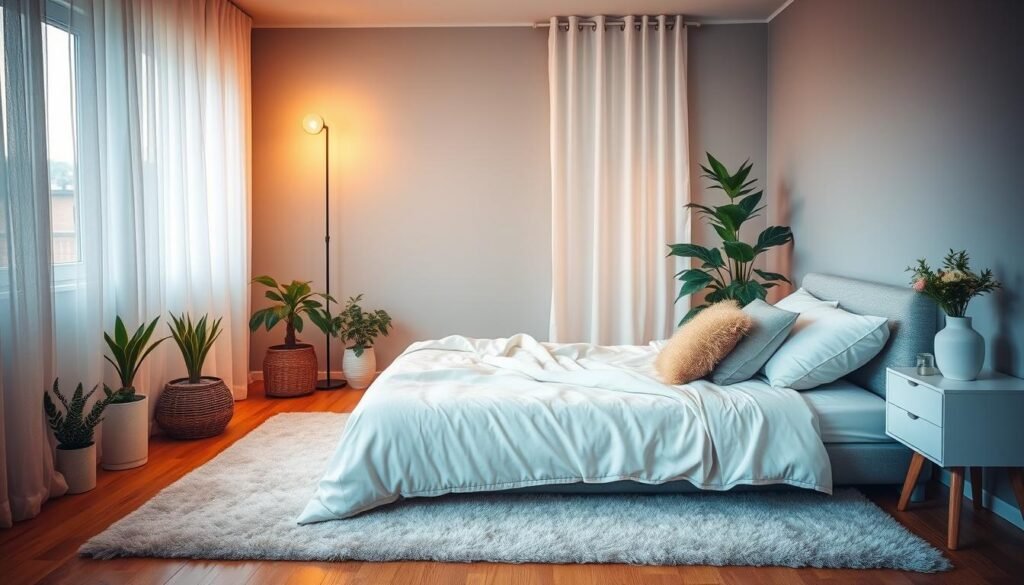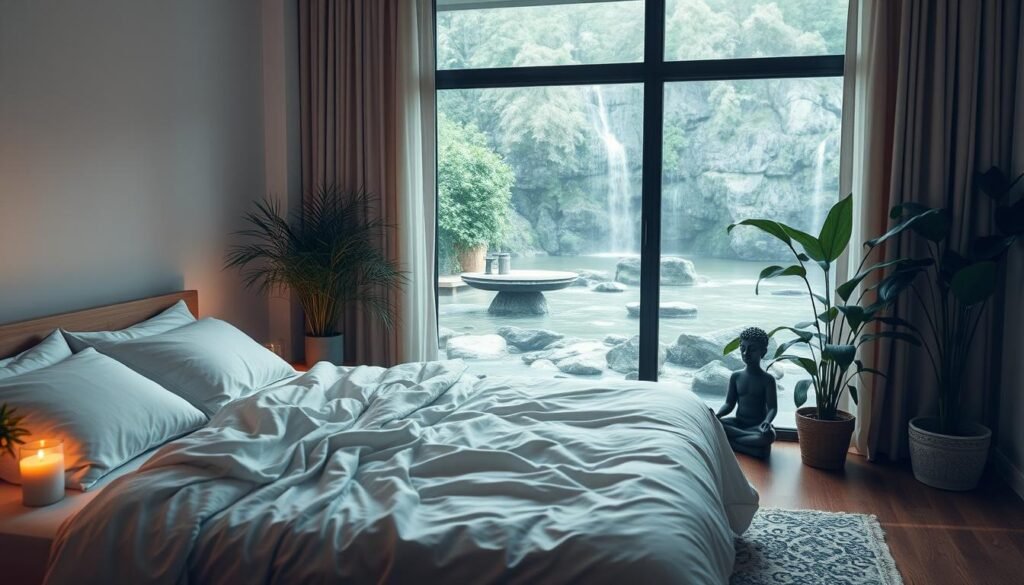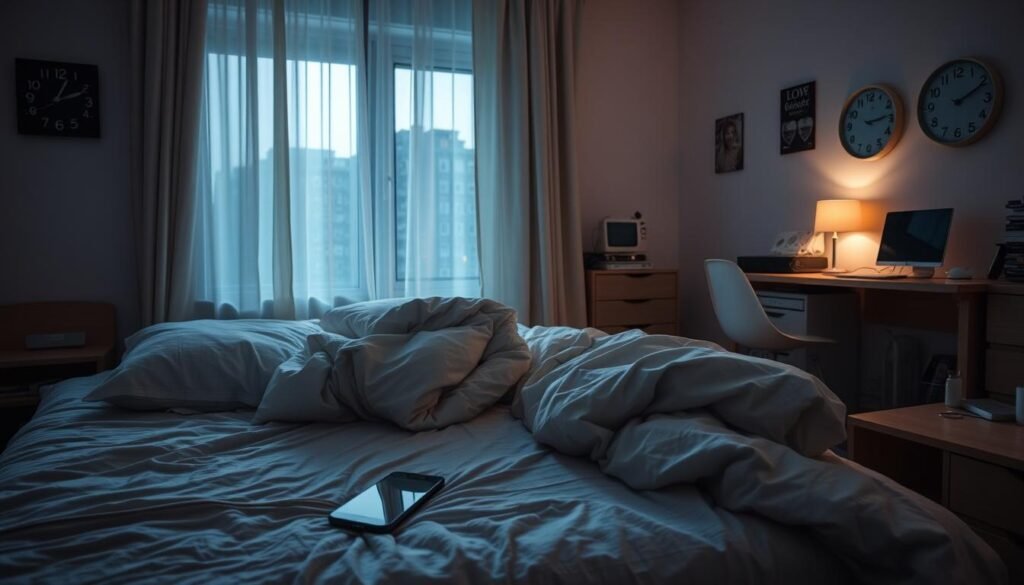Many people in the United States struggle to fall asleep fast. This problem affects 1 in 3 people, leading to sleep deprivation. We will look at sleep techniques, like the military method, to help you sleep in 2 minutes or less. Our aim is to give you a detailed guide on how to fall asleep quickly.
We will explore various sleep techniques. These include relaxation, breathing, and visualizing a calm scene. We will also talk about improving sleep hygiene. By mastering these, you can learn to fall asleep in 2 minutes or less.
Table of Contents
ToggleKey Takeaways
- 1 in 3 people in the United States experience sleep deprivation, making it essential to learn how to fall asleep quickly.
- The military method has a reported 96% success rate in helping individuals fall asleep within approximately 120 seconds.
- Consistent practice of relaxation techniques can improve the likelihood of falling asleep quickly over time, making it a critical part of any bedtime routine.
- Creating a sleep-conducive environment, including a cool room temperature and minimal light exposure, can significantly enhance sleep quality.
- Regular sleep patterns and a consistent bedtime routine are key for better sleep onset latency and overall quality, helping you fall asleep fast and wake up refreshed.
Understanding the Science Behind Quick Sleep
Exploring quick sleep reveals the science behind it. Our sleep cycle has stages like light sleep and deep sleep. Each stage is vital for good sleep quality. Brain waves, such as alpha and beta, help us relax and sleep.
A sleep cycle lasts 70 to 120 minutes. It has four stages: NREM Stage 1, NREM Stage 2, NREM Stage 3, and REM sleep. These stages are key for our health. Fast sleep is also important for feeling refreshed.
But, traditional methods often miss the mark. They can lead to insomnia and fatigue. Knowing the science of quick sleep helps us find better ways to sleep well.
Several factors affect our sleep. These include:
- Light exposure and our circadian rhythms
- Hormones like melatonin and cortisol
- Our need for sleep after being awake
Understanding these factors helps us grasp our sleep cycle better. Next, we’ll look at the military method for quick sleep and how it can make us fall asleep fast.
The Military Method: Can We Sleep in 2 Minutes How?
The military method is a sleep technique for quick sleep, even in stressful times. It relaxes the face, shoulders, and body, and clears the mind. This way, we can fall asleep quickly and sleep better.
Some key benefits of the military method include:
- Reduced stress and anxiety
- Improved sleep quality
- Increased focus and concentration
Research shows the military method can help fall asleep quickly. It can do so in under two minutes. It also helps those with insomnia, lasting up to four decades.
To master the military method, practice it for six weeks. This builds the skills for falling asleep quickly and better sleep. Using the military method improves health and well-being, making us wake up refreshed.
| Method | Benefits | Results |
|---|---|---|
| Military Method | Reduced stress and anxiety, improved sleep quality | Fall asleep in under two minutes |
Preparing Your Body for Rapid Sleep
Managing light exposure is important. Avoid screens and bright lights before bed. Instead, use dim red lights to signal it’s time to sleep. A cool room temperature, between 60-67 degrees Fahrenheit, also helps us sleep well.
Using physical relaxation techniques is also vital. Activities like progressive muscle relaxation, mindfulness meditation, and yoga can help. They reduce stress and make it easier to fall asleep. By doing these activities daily, we can sleep better and feel more alert in the morning.
Tips for Preparing Your Body for Sleep
- Stick to a consistent sleep schedule to regulate your body’s internal clock
- Avoid electronic devices before bedtime to reduce light exposure
- Practice physical relaxation techniques, such as yoga or meditation, to reduce stress and anxiety
- Create a sleep-conducive environment, including optimal room temperature and darkness
By following these tips, we can sleep better and wake up feeling refreshed. Remember, it’s not just about the environment. Managing light and practicing relaxation techniques are also important. With practice, we can master rapid sleep and wake up feeling great.
| Sleep Stage | Duration | Benefits |
|---|---|---|
| Light Sleep | 30-60 minutes | Restores energy, repairs tissues |
| Deep Sleep | 60-90 minutes | Boosts immune system, improves cognitive function |
| REM Sleep | 90-120 minutes | Enhances memory, promotes learning and creativity |
Creating the Perfect Sleep Environment
To fall asleep quickly, we need a sleep-friendly space. This means a cool, dark, and quiet room. Plus, a comfy bed is key. A comfortable bed supports our bodies well, helping us sleep better.
A quiet room is vital, as noise can mess with our sleep. We can use earplugs, white noise machines, or soundproofing to keep it quiet. Darkness is also important, as light can stop melatonin production. Blackout curtains or blinds help block out light.
Here are some tips for the perfect sleep environment:
- Keep the room at a comfortable temperature, between 60 and 67 degrees Fahrenheit.
- Use a comfortable mattress and pillows.
- Reduce noise levels with earplugs, white noise machines, or soundproofing materials.
- Block out light with blackout curtains or blinds.

Creating a sleep-friendly space can make us sleep better and faster. Good sleep is key for our health. It makes us feel ready for the next day.
Research shows a cool, dark, and quiet room improves sleep quality. A good mattress, pillows, and less noise and light make the perfect sleep space. We wake up feeling refreshed.
When it comes to falling asleep quickly, breathing techniques are key. The 4-7-8 breathing method is very effective. It involves breathing in through the nose, holding, and then exhaling through the mouth. This can slow down your heart rate and help you relax.
Box breathing is another great technique. It means inhaling, holding, exhaling, and waiting for 4 seconds each. This can calm your mind and lower stress. Naval breathing exercises also help, by strengthening your diaphragm and improving lung function.
Some benefits of these breathing techniques include:
- Reduced anxiety and stress
- Improved sleep quality
- Increased melatonin production
- Enhanced relaxation and calmness
It’s important to practice these techniques often to see the best results. Start with short sessions and gradually increase the time as you get more comfortable.
| Technique | Benefits | Practice Duration |
|---|---|---|
| 4-7-8 Breathing Method | Reduced anxiety, improved sleep quality | 3-4 cycles, 2-3 times a day |
| Box Breathing | Calmed mind, reduced stress | 4-6 cycles, 2-3 times a day |
| Naval Breathing Exercises | Strengthened diaphragm, improved lung function | 5-10 minutes, 3-4 times a day |
Mind Relaxation Strategies
Exploring rapid sleep, we find mind relaxation strategies key for a good night’s sleep. Techniques like visualization and progressive muscle relaxation calm our minds and bodies. This makes it easier to fall asleep. By adding these to our daily routine, we can lower stress and anxiety, leading to better sleep.
Some important mind relaxation strategies include:
- Visualization: imagining a peaceful scene to calm the mind
- Progressive muscle relaxation: tensing and relaxing different muscle groups to release physical tension
These methods can help improve sleep quality and reduce sleep disorders. The Cleveland Clinic notes that one in three people face sleep issues. This shows the need for effective mind relaxation strategies.
Combining these strategies with other methods, like the 4-7-8 breathing method and a consistent sleep schedule, can enhance sleep quality. Creating a sleep-friendly environment, free from distractions, is also vital. As we dive deeper into rapid sleep, we’ll look at more ways to get a good night’s rest.
Remember, regular practice of relaxation exercises is key. By making mind relaxation a daily habit, we can better our sleep, reduce stress, and wake up feeling refreshed.
| Mind Relaxation Strategy | Description |
|---|---|
| Visualization | Imagining a peaceful scene to calm the mind |
| Progressive Muscle Relaxation | Tensing and relaxing different muscle groups to release physical tension |
Pre-Sleep Routine Optimization
To get better sleep, we need to focus on our pre-sleep routine. This means managing our digital devices, eating right in the evening, and timing our activities. By doing these things, we can make our sleep environment better. This helps us fall asleep faster and wake up feeling good.
Managing digital devices is key. The blue light from phones and computers can stop our bodies from making melatonin. This makes it hard to sleep. We can avoid screens for an hour before bed or use special glasses or apps.
Evening Nutrition Guidelines
What we eat in the evening is also important. A light snack like fruit or yogurt can help us sleep. But, eating too much can make us feel sick and keep us awake. It’s best to avoid caffeine and nicotine before bed too.
Timing Activities
When we do things is just as important. Doing calm activities like reading or meditating can help us relax. It’s also good to go to bed and wake up at the same time every day.
By following these tips, we can sleep better and feel refreshed. Good sleep is key for our health, so it’s worth making it a priority.
| Activity | Timing | Benefits |
|---|---|---|
| Reading | 30 minutes before bed | Relaxation and reduced stress |
| Meditation | 20 minutes before bed | Improved sleep quality and reduced anxiety |
| Exercise | 2-3 hours before bed | Improved sleep quality and physical health |
Common Obstacles to Quick Sleep
Trying to fall asleep quickly can be tough. Stress and anxiety are big hurdles. They make our minds race, making it hard to relax and sleep.
Deep breathing and progressive muscle relaxation can help manage stress and anxiety. These techniques calm the mind and body.
Physical discomfort is another big obstacle. A comfy sleep environment helps a lot. This includes supportive pillows and mattresses.
Keeping the room cool and quiet is also key. Using earplugs, eye masks, and blackout curtains can block out light and noise.
Here are some strategies to beat these obstacles:
- Establishing a consistent sleep schedule
- Creating a relaxing bedtime routine
- Optimizing the sleep environment
By using these strategies and managing stress and anxiety, we can reduce physical discomfort and environmental disturbances. This helps us fall asleep faster.

Join 30,000+ subscribers for exclusive access to our Relaxing tips!
It’s vital to tackle these common obstacles to quick sleep. Doing so improves our sleep quality and overall well-being. We wake up feeling refreshed and ready for the day.
Building Long-Term Quick Sleep Habits
Improving our sleep quality is key, and building long-term habits is essential. We need a consistent sleep schedule and bedtime routine. This helps our body’s internal clock and trains our brain to sleep better.
Consistency is vital for quick sleep habits. We should go to bed and wake up at the same time every day. A cool, dark bedroom also helps sleep quality. Patience is needed as our body adjusts to new habits.
To get better sleep, try these tips:
- Establish a consistent sleep schedule
- Create a bedtime routine to signal to your brain that it’s time to sleep
- Optimize your sleep environment to promote relaxation
By sticking to these tips and being consistent and patient, we can build long-term habits. These habits will improve our sleep and overall health.
| Tip | Description |
|---|---|
| Establish a consistent sleep schedule | Go to bed and wake up at the same time every day |
| Create a bedtime routine | Develop a calming pre-sleep routine to signal to your brain that it’s time to sleep |
| Optimize your sleep environment | Keep your bedroom cool, dark, and quiet to promote relaxation |
Conclusion: Mastering the Two-Minute Sleep Technique
Mastering the two-minute sleep technique takes dedication, practice, and patience. By following the strategies and techniques in this article, we can quickly fall asleep. This leads to a well-rested mind and body.
The military-developed method focuses on relaxation and breath control. It has shown to be very effective. In fact, 96% of people can fall asleep in two minutes after six weeks of practice.
This technique was first mentioned in “Relax and Win: Championship Performance” in 1981. It has become popular on TikTok, with over 7.2 million views on a demonstration video.
Consistency is important. Make the two-minute sleep technique a part of your nightly routine. Regular practice helps develop healthy sleep habits. By creating a sleep-friendly environment and managing stress, we can all fall asleep quickly and enjoy a good night’s rest.
FAQ
What is the science behind quick sleep?
Our sleep cycle has different stages like light sleep and deep sleep. Brain waves also play a key role, with alpha, beta, and theta waves helping us relax and fall asleep. Traditional sleep methods often fail because they don’t tackle the real sleep quality issues.
What is the military method for falling asleep quickly?
The military method is a technique used by the US military to help soldiers sleep fast in stressful times. It involves relaxing your face, shoulders, and body, and clearing your mind. By practicing this, you can fall asleep quickly and improve your sleep quality.
How can I prepare my body for rapid sleep?
To fall asleep fast, it’s key to prepare your body. This means creating a good sleep environment, managing light, and relaxing physically. A cool room, around 60-67 degrees Fahrenheit, helps sleep better. Avoid screens and bright lights before bed, and try stretching or yoga to relax your body.
What are the essential breathing techniques for quick sleep?
Breathing techniques can relax you and help you fall asleep quickly. The 4-7-8 breathing method, or relaxation breath, involves breathing in, holding, and exhaling. Box breathing and naval breathing also help relax and reduce stress.
How can mind relaxation strategies help me fall asleep faster?
Mind relaxation strategies calm your mind and help you sleep fast. Visualization lets you imagine a peaceful scene, while progressive muscle relaxation tenses and relaxes muscles. These techniques reduce stress and anxiety, leading to better sleep.
What should I include in my pre-sleep routine to optimize quick sleep?
A good pre-sleep routine is key for quick sleep. This includes managing digital devices, following nutrition guidelines, and timing activities. Avoid screens before bed to reduce blue light and promote sleep. A consistent sleep schedule and a relaxing bedtime routine also improve sleep quality.
What are the common obstacles to quick sleep, and how can I overcome them?
Common sleep obstacles include stress, physical discomfort, and environmental disturbances. Stress and anxiety can be managed with deep breathing and muscle relaxation. Physical discomfort can be fixed by creating a comfortable sleep environment and using supportive pillows and mattresses. To reduce environmental disturbances, use earplugs, eye masks, and blackout curtains.




Pingback: Is Oversleeping A Myth?
Pingback: How Can I Sleep 8.5 Hours?
Pingback: How Do I Stop Overthinking Easily?